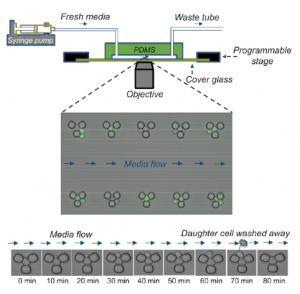Biochemistry is a branch of the science of great interest for the development of industrial products. In this field, a wide variety of applications in the food and health industries are derived from microorganisms, enzymes, and tissues. The fundamental characteristics of enzymes, cell and tissue cultures are crucial to the development of high-value products. These studies include morphological characterization, enzyme kinetics, and kinetic growth amount others.
The biochemical characterization techniques are based in most cases on the detection of a product or the amount of substrate that disappear due to the biological activity. The classical techniques present drawbacks because manual operation and mass transport are challenging. To overcome these issues, since the 1970s flow injection analysis (FIA) has become an exciting option. FIA can be coupled to different detectors allowing its implementation in electrochemical, mass spectrometry and chemiluminescence techniques. In the next paragraphs, a few examples of the FIA advantages in fundamental biochemical studies will be presented.
Syringe pumps for high-speed enzyme kinetics.
The catalytic activity of enzymes is usually studied at the beginning of the reaction, where the concentration of the products increases rapidly and linearly. After a period, the reaction rate decrease due to the accumulation of the product. Therefore, the initial reaction rate offers more accurate results in the determination of the Michaelis-Menten constant (Km) and maximum velocity (Vmax)2. Flow cells are implemented to achieve this linear relationship by the manipulation of the flow of solution, increasing sensitivity and accuracy in enzymatic reactions of high speed.
Simultaneous microorganism studies with FIA.
In the case of microorganisms, FIA helps in the study of effective reaction rates in biofilms, which have been quite challenging for engineers in industrial processes of interest such as the agricultural wastewater treatment1. Also, this kind of microfluidic platform can be used to study gene expression and aging of yeast cells without expensive micromanipulation equipment. The implementation of this technique allows the simultaneous study of different yeast strains and the growth media effect (Liu, Young, & Acar, 2015).

Simultaneous microorganism studies with FIA.
Another interesting application for FIA takes place in the detection at the molecular level. The detection of a single molecule in a biological process it is possible thanks to the methods like fluorescent tagging and immunoassays. However, these methods are expensive and difficult to produce. Recently, Su and coworkers have developed a novel label-free detection of biological molecules based on optical sensors in a flow analysis system4.
Conclusion
In all the examples mentioned here, the proper flow manipulation plays a critical role were a reliable, stable and pulseless flow is mandatory. The flow manipulation in all cases was carried out by laboratory syringe pumps, which are well known to fulfill such requirements from the nL to the µL range. Flow injection analysis, provide a straightforward methodology to accomplished the study of the most complex biochemical systems. The flow-based experiments designed with Chemyx syringe pumps allow high-precision determinations. Furthermore, outstanding single cell or strain information can be gathered without complicated setups. The flow manipulation is a robust technology that will provide new and exciting information of the most intricate biochemical systems.
References
- Connolly, J. M., Jackson, B., Rothman, A. P., Klapper, I., & Gerlach, R. (2015). Estimation of a biofilm-specific reaction rate: Kinetics of bacterial urea hydrolysis in a biofilm. Npj Biofilms and Microbiomes, 1(April), 1–8. https://doi.org/10.1038/npjbiofilms.2015.14
- Hartwell, S. K., & Grudpan, K. (2012). Flow-based systems for rapid and high-precision enzyme kinetics studies. Journal of Analytical Methods in Chemistry, 1(1). https://doi.org/10.1155/2012/450716
- Liu, P., Young, T. Z., & Acar, M. (2015). Yeast Replicator: A High-Throughput Multiplexed Microfluidics Platform for Automated Measurements of Single-Cell Aging. Cell Reports, 13(3), 1–11. https://doi.org/10.1016/j.celrep.2015.09.012
- Su, J., Goldberg, A. F., & Stoltz, B. M. (2016). Label-free detection of single nanoparticles and biological molecules using microtoroid optical resonators. Light: Science & Applications, 5(1), e16001. https://doi.org/10.1038/lsa.2016.1

